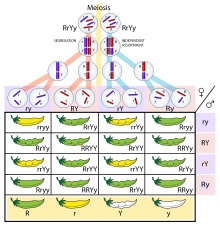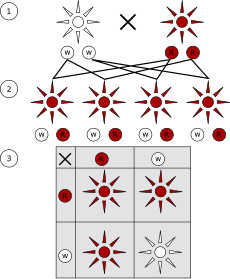
| Home | Sources Directory | News Releases | Calendar | Articles | | Contact | |
Mendelian inheritance
| Part of the Biology series on |
| Genetics |
| Key components |
|---|
|
Chromosome |
| History and topics |
|
Classical genetics |
| Research |
|
DNA sequencing |
| Biology portal ' |
Mendelian inheritance (or Mendelian genetics or Mendelism) is a set of primary tenets relating to the transmission of hereditary characteristics from parent organisms to their offspring; it underlies much of genetics. They were initially derived from the work of Gregor Mendel published in 1865 and 1866 which was "re-discovered" in 1900, and were initially very controversial. When they were integrated with the chromosome theory of inheritance by Thomas Hunt Morgan in 1915, they became the core of classical genetics.
Contents |
[edit] History
The laws of inheritance were derived by Gregor Mendel, a 19th century Austrian Priest/monk conducting hybridization experiments in garden peas (Pisum sativum).[1] Between 1856 and 1863, he cultivated and tested some 29,000 pea plants. From these experiments he deduced two generalizations which later became known as Mendel's Principles of Heredity or Mendelian inheritance. He described these principles in a two part paper, Experiments on Plant Hybridization that he read to the Natural History Society of Brno on February 8 and March 8, 1865, and which was published in 1866.[2]
Mendel's conclusions were largely ignored. Although they were not completely unknown to biologists of the time, they were not seen as generally applicable, even by Mendel himself, who thought they only applied to certain categories of species or traits. A major block to understanding their significance was the importance attached by 19th century biologists to the apparent blending of inherited traits in the overall appearance of the progeny, now known to be due to multigene interactions, in contrast to the organ-specific binary characters studied by Mendel.[1] In 1900, however, his work was "re-discovered" by three European scientists, Hugo de Vries, Carl Correns, and Erich von Tschermak. The exact nature of the "re-discovery" has been somewhat debated: De Vries published first on the subject, mentioning Mendel in a footnote, while Correns pointed out Mendel's priority after having read De Vries's paper and realizing that he himself did not have priority. De Vries may not have acknowledged truthfully how much of his knowledge of the laws came from his own work, or came only after reading Mendel's paper. Later scholars have accused Von Tschermak of not truly understanding the results at all.[1]
Regardless, the "re-discovery" made Mendelism an important but controversial theory. Its most vigorous promoter in Europe was William Bateson, who coined the term "genetics", "gene", and "allele" to describe many of its tenets. The model of heredity was highly contested by other biologists because it implied that heredity was discontinuous, in opposition to the apparently continuous variation observable for many traits. Many biologists also dismissed the theory because they were not sure it would apply to all species, and there seemed to be very few true Mendelian characters in nature. However later work by biologists and statisticians such as R.A. Fisher showed that if multiple Mendelian factors were involved in the expression of an individual trait, they could produce the diverse results observed. Thomas Hunt Morgan and his assistants later integrated the theoretical model of Mendel with the chromosome theory of inheritance, in which the chromosomes of cells were thought to hold the actual hereditary material, and create what is now known as classical genetics, which was extremely successful and cemented Mendel's place in history.
Mendel's findings allowed other scientists to predict the expression of traits on the basis of mathematical probabilities. A large contribution to Mendel's success can be traced to his decision to start his crosses only with plants he demonstrated were true-breeding. He also only measured absolute (binary) characteristics, such as color, shape, and position of the offspring, rather than quantitative characteristics. He expressed his results numerically and subjected them to statistical analysis. His method of data analysis and his large sample size gave credibility to his data. He also had the foresight to follow several successive generations (f2, f3) of his pea plants and record their variations. Finally, he performed "test crosses" (back-crossing descendants of the initial hybridization to the initial true-breeding lines) to reveal the presence and proportion of recessive characters. Without his hard work and careful attention to procedure and detail, Mendel's work could not have had the impact it made on the world of genetics.
[edit] Mendel's Laws
Mendel discovered that by crossing white flower and purple flower plants, the result was not a blend. Rather than being a mix of the two, the offspring was purple flowered. He then conceived the idea of heredity units, which he called "factors", one of which is a recessive characteristic and the other dominant. Mendel said that factors, later called genes, normally occur in pairs in ordinary body cells, yet segregate during the formation of sex cells. Each member of the pair becomes part of the separate sex cell. The dominant gene, such as the purple flower in Mendel's plants, will hide the recessive gene, the white flower. After Mendel self-fertilized the F1 generation and obtained the 3:1 ratio, he correctly theorized that genes can be paired in three different ways for each trait: AA, aa, and Aa. The capital "A" represents the dominant factor and lowercase "a" represents the recessive. (The last combination listed above, Aa, will occur roughly twice as often as each of the other two, as it can be made in two different ways, Aa or aA.)
Mendel stated that each individual has two factors for each trait, one from each parent. The two factors may or may not contain the same information. If the two factors are identical, the individual is called homozygous for the trait. If the two factors have different information, the individual is called heterozygous. The alternative forms of a factor are called alleles. The genotype of an individual is made up of the many alleles it possesses. An individual's physical appearance, or phenotype, is determined by its alleles as well as by its environment. An individual possesses two alleles for each trait; one allele is given by the female parent and the other by the male parent. They are passed on when an individual matures and produces gametes: egg and sperm. When gametes form, the paired alleles separate randomly so that each gamete receives a copy of one of the two alleles. The presence of an allele doesn't promise that the trait will be expressed in the individual that possesses it. In heterozygous individuals the only allele that is expressed is the dominant. The recessive allele is present but its expression is hidden.
Mendel summarized his findings in two laws; the Law of Segregation and the Law of Independent Assortment.
[edit] Law of Segregation (The "First Law")
The Law of Segregation states that when any individual produces gametes, the copies of a gene separate so that each gamete receives only one copy. A gamete will receive one allele or the other. The direct proof of this was later found when the process of meiosis came to be known. In meiosis the paternal and maternal chromosomes get separated and the alleles with the traits of a character are segregated into two different gametes.
[edit] Law of Independent Assortment (The "Second Law")
The Law of Independent Assortment, also known as "Inheritance Law", states that alleles of different genes assort independently of one another during gamete formation. While Mendel's experiments with mixing one trait always resulted in a 3:1 ratio (Fig. 1) between dominant and recessive phenotypes, his experiments with mixing two traits (dihybrid cross) showed 9:3:3:1 ratios (Fig. 2). But the 9:3:3:1 table shows that each of the two genes are independently inherited with a 3:1 phenotypic ratio. Mendel concluded that different traits are inherited independently of each other, so that there is no relation, for example, between a cat's color and tail length. This is actually only true for genes that are not linked to each other.
Independent assortment occurs during meiosis I in eukaryotic organisms, specifically metaphase I of meiosis, to produce a gamete with a mixture of the organism's maternal and paternal chromosomes. Along with chromosomal crossover, this process aids in increasing genetic diversity by producing novel genetic combinations.
Of the 46 chromosomes in a normal diploid human cell, half are maternally-derived (from the mother's egg) and half are paternally-derived (from the father's sperm). This occurs as sexual reproduction involves the fusion of two haploid gametes (the egg and sperm) to produce a new organism having the full complement of chromosomes. During gametogenesis'the production of new gametes by an adult'the normal complement of 46 chromosomes needs to be halved to 23 to ensure that the resulting haploid gamete can join with another gamete to produce a diploid organism. An error in the number of chromosomes, such as those caused by a diploid gamete joining with a haploid gamete, is termed aneuploidy.
In independent assortment the chromosomes that end up in a newly-formed gamete are randomly sorted from all possible combinations of maternal and paternal chromosomes. Because gametes end up with a random mix instead of a pre-defined "set" from either parent, gametes are therefore considered assorted independently. As such, the gamete can end up with any combination of paternal or maternal chromosomes. Any of the possible combinations of gametes formed from maternal and paternal chromosomes will occur with equal frequency. For human gametes, with 23 pairs of chromosomes, the number of possibilities is 223 or 8,388,608 possible combinations.[3] The gametes will normally end up with 23 chromosomes, but the origin of any particular one will be randomly selected from paternal or maternal chromosomes. This contributes to the genetic variability of progeny.

Figure 2: The phenotypes of two independent traits show a 9:3:3:1 ratio in the F2 generation. In this example, coat color is indicated by B (brown, dominant) or b (white) while tail length is indicated by S (short, dominant) or s (long). When parents are homozygous for each trait ('SSbb and ssBB), their children in the F1 generation are heterozygous at both loci and only show the dominant phenotypes. If the children mate with each other, in the F2 generation all combination of coat color and tail length occur: 9 are brown/short (purple boxes), 3 are white/short (pink boxes), 3 are brown/long (blue boxes) and 1 is white/long (green box).
|

Figure 3: The color alleles of Mirabilis jalapa are not dominant or recessive.
(1) Parental generation. (2) F1 generation. (3) F2 generation. The "red" and "white" allele together make a "pink" phenotype, resulting in a 1:2:1 ratio of red:pink:white in the F2 generation. |
[edit] Background


The reason for these laws is found in the nature of the cell nucleus. It is made up of several chromosomes carrying the genetic traits. In a normal cell, each of these chromosomes has two parts, the chromatids. A reproductive cell, which is created in a process called meiosis, usually contains only one of those chromatids of each chromosome. By merging two of these cells (usually one male and one female), the full set is restored and the genes are mixed. The resulting cell becomes a new embryo. The fact that this new life has half the genes of each parent (23 from mother, 23 from father for total of 46) is one reason for the Mendelian laws. The second most important reason is the varying dominance of different genes, causing some traits to appear unevenly instead of averaging out (whereby dominant doesn't mean more likely to reproduce'recessive genes can become the most common, too).
There are several advantages of this method (sexual reproduction) over reproduction without genetic exchange:
- Instead of nearly identical copies of an organism, a broad range of offspring develops, allowing more different abilities and evolutionary strategies.
- There are usually some errors in every cell nucleus. Copying the genes usually adds more of them. By distributing them randomly over different chromosomes and mixing the genes, such errors will be distributed unevenly over the different children. Some of them will therefore have only very few such problems. This helps reduce problems with copying errors somewhat.
- Genes can spread faster from one part of a population to another. This is for instance useful if there's a temporary isolation of two groups. New genes developing in each of the populations don't get reduced to half when one side replaces the other, they mix and form a population with the advantages of both sides.
- Sometimes, a mutation (e. g. sickle cell anemia) can have positive side effects (in this case malaria resistance). The mechanism behind the Mendelian laws can make it possible for some offspring to carry the advantages without the disadvantages until further mutations solve the problems.
[edit] Mendelian trait
A Mendelian trait is one that is controlled by a single locus and shows a simple Mendelian inheritance pattern. In such cases, a mutation in a single gene can cause a disease that is inherited according to Mendel's laws. Examples include sickle-cell anemia, Tay-Sachs disease, cystic fibrosis and xeroderma pigmentosa. A disease controlled by a single gene contrasts with a multi-factorial disease, like arthritis, which is affected by several loci (and the environment) as well as those diseases inherited in a non-Mendelian fashion. The Mendelian Inheritance in Man database is a catalog of, among other things, genes in which Mendelian traits cause disease.
[edit] See also
- Non-Mendelian inheritance
- Dominance relationship
- Heritability
- Particulate inheritance
- Mendelian error
- List of Mendelian traits in humans
- Punnett square
- Gregor Mendel
[edit] References
- ^ a b c Henig, Robin Marantz (2009). The Monk in the Garden : The Lost and Found Genius of Gregor Mendel, the Father of Genetics. Houghton Mifflin. ISBN 0-395-97765-7. "The article, written by a monk named Gregor Mendel..."
- ^ See Mendel's paper in English: Gregor Mendel (1865). "Experiments in Plant Hybridization". http://www.mendelweb.org/Mendel.html.
- ^ Perez, Nancy. "Meiosis". http://www.web-books.com/MoBio/Free/Ch8C.htm. Retrieved 2007-02-15.
- Peter J. Bowler (1989). The Mendelian Revolution: The Emergence of Hereditarian Concepts in Modern Science and Society. Baltimore: Johns Hopkins University Press.
- Atics, Jean. Genetics:The life of DNA. ANDRNA press.
|
SOURCES.COM is an online portal and directory for journalists, news media, researchers and anyone seeking experts, spokespersons, and reliable information resources. Use SOURCES.COM to find experts, media contacts, news releases, background information, scientists, officials, speakers, newsmakers, spokespeople, talk show guests, story ideas, research studies, databases, universities, associations and NGOs, businesses, government spokespeople. Indexing and search applications by Ulli Diemer and Chris DeFreitas.
For information about being included in SOURCES as a expert or spokesperson see the FAQ . For partnerships, content and applications, and domain name opportunities contact us.

